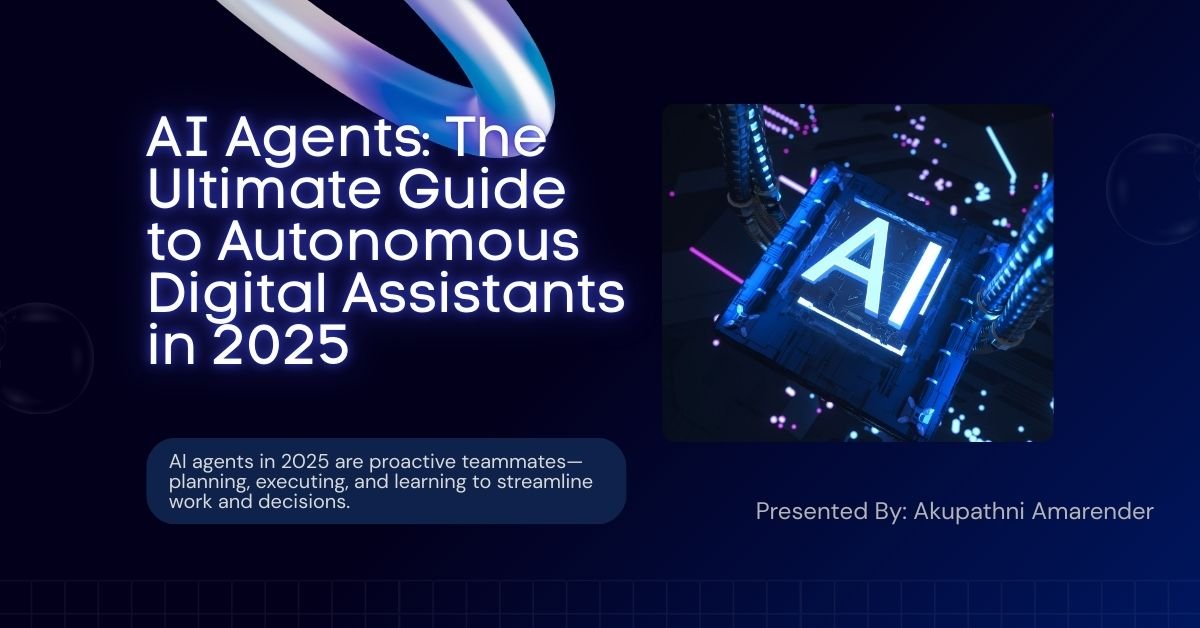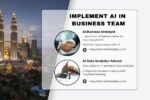Imagine having a digital teammate that not only follows instructions but also thinks ahead, makes decisions, and learns from experience. That’s exactly what AI agents are bringing to the table in 2025. Businesses, creators, and everyday users are discovering that these autonomous assistants can save time, unlock creativity, and handle tasks once thought impossible for machines.
The rise of autonomous assistants is more than a tech trend—it’s changing how we work, collaborate, and live. For a deeper dive into related tools and tutorials, check out our AI Guides

What Are AI Agents? (Simple Definition)
In simple terms, autonomous programs are designed to act independently to achieve goals. Unlike traditional software, which waits for commands, they can:
Observe their environment.
Decide on the best action.
Execute tasks with minimal human input.
Think of them as digital assistants on autopilot, capable of handling repetitive jobs and creative projects alike.
Key Concepts You Should Know
To understand how these autonomous systems work, let’s break down a few key terms
Artificial Intelligence (AI): Machines simulating human-like intelligence, such as learning, problem-solving, and reasoning.
Autonomy: The ability of an agent to act without direct control.
Productivity: Getting more work done with less effort. AI agents boost productivity by automating routine tasks.
Creativity: Generating new ideas or content. Some AI agents even write, design, or compose music.
Why 2025 Is the Year of AI Agents
Until recently, most AI tools acted only on direct prompts. In 2025, we’re seeing a leap forward: autonomous systems can now plan, act, and adapt in real time
💡 Surprising Fact: A recent study found that companies using autonomous agents report a 32% increase in efficiency compared to those using standard AI tools.
How AI Agents Work (Step by Step)

Here’s a simplified process:
Input Gathering – The agent observes data from apps, systems, or the internet.
Decision-Making – It evaluates options using algorithms and past learning.
Action Execution – The agent carries out tasks, such as sending emails or running simulations.
Feedback Loop – It learns from outcomes and improves for next time.
This cycle repeats continuously, making the system smarter with each use.
Real-World Applications of AI Agents
You’ll find these autonomous assistants in nearly every sector today. Here are a few examples: For step-by-step examples in business, healthcare, and construction, see our AI Guides. According to a report by McKinsey & Company, companies using autonomous systems can improve productivity by over 30%
Business: Automating customer support, scheduling, and financial analysis.
Construction: Managing supply chains, monitoring safety, and optimizing materials use.
Healthcare: Assisting with diagnostics, patient care, and research.
Marketing: Running personalized campaigns and analyzing customer behavior.
Personal Life: Managing calendars, shopping online, or even tutoring.
Benefits of AI Agents
Why are AI agents gaining so much attention? Here’s what they offer. In online retail, they provide instant support, personalized recommendations, and scale effortlessly—explore more about AI agents for online retail here
Save time by handling repetitive tasks.
Boost accuracy in decision-making.
Reduce operational costs.
Provide 24/7 availability.
Encourage creativity by freeing up human focus.
Limitations to Keep in Mind
Like any technology, these digital assistants come with challenges:
Dependence on data quality – Poor input leads to poor output.
Security concerns – Systems that act independently may pose risks if not managed.
Ethical questions – Decisions made without human oversight can spark debates.
Practical Tips: How to Use Them Today
Want to get started with autonomous assistants? Here are a few steps:
Choose the right tool – Popular platforms include Auto-GPT, CrewAI, and enterprise solutions.
Start small – Assign simple tasks like scheduling or research.
Monitor results – Regularly check performance and adjust.
Scale up – Gradually move into more complex projects once trust is built.
FAQs About AI Agents
Q1: Are AI agents the same as chatbots?
No. Chatbots respond to prompts, while autonomous systems can plan, act, and adapt independently.
Q2: Do I need coding skills to use them?
Not always. Many no-code platforms make it easy to set up AI agents with drag-and-drop tools.
Q3: Can AI agents replace human workers?
They’re more about collaboration than replacement. AI agents handle repetitive work, allowing humans to focus on strategy and creativity.
Future Outlook: Where AI Agents Are Heading
By 2030, experts predict that AI agents will be as common as smartphones today. They will not only support individuals but also drive industries, from logistics to space exploration.
The future isn’t about humans versus machines. It’s about humans working with AI agents to achieve more than ever before.
Summary: Key Takeaways
Autonomous digital assistants are designed to act independently
They enhance productivity, creativity, and decision-making.
Applications span across business, healthcare, construction, and daily life.
While powerful, they require ethical, secure, and careful use.
Getting started is simple: pick a tool, assign tasks, and scale up.
Next Steps: Learn More
If you’re ready to dive deeper, explore resources like:
OpenAI’s research on autonomous systems.
Case studies of autonomous assistants in business and healthcare.
Tutorials on Auto-GPT and CrewAI.
The world of AI agents is just beginning. By embracing these digital assistants now, you’ll be ahead of the curve in 2025 and beyond.

Hi, I’m Amarender Akupathni — founder of Amrtech Insights and a tech enthusiast passionate about AI and innovation. With 10+ years in science and R&D, I simplify complex technologies to help others stay ahead in the digital era.



